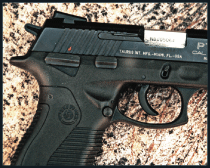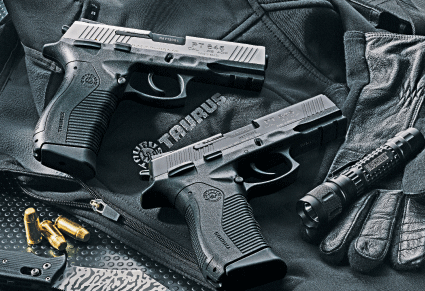When the United States Special Operations Command announced that it was considering adopting a new service handgun, and laid down the performance requirements for the pistol, a number of handgun makers responded. The result was several new handgun designs that, in light of the postponement of the SOCOM tests, have now been made available to the civilian market.
 One was the Taurus 24/7 OSS. As a full-sized service handgun it’s proven to be rugged and reliable. But it’s a bit much to pack concealed on a daily basis. Taurus responded by taking some of the ergonomic features of the 24/7 OSS, adding a few innovations, trimming the size and weight, and introduced a new line of mid-sized semi-auto handguns. The result was the Taurus 800 Series that was introduced in 2008. It is available in 9mm (PT809, 17+1) .40 (PT840, 15+1) and .45ACP (PT845, 12+1). For our test we had the big bore .45ACP model.
One was the Taurus 24/7 OSS. As a full-sized service handgun it’s proven to be rugged and reliable. But it’s a bit much to pack concealed on a daily basis. Taurus responded by taking some of the ergonomic features of the 24/7 OSS, adding a few innovations, trimming the size and weight, and introduced a new line of mid-sized semi-auto handguns. The result was the Taurus 800 Series that was introduced in 2008. It is available in 9mm (PT809, 17+1) .40 (PT840, 15+1) and .45ACP (PT845, 12+1). For our test we had the big bore .45ACP model.
RELATED: Taurus 709 Slim 9mm | Gun Review
Advertisement — Continue Reading Below
The PT845 .45ACP is built on a polymer frame with either a forged steel slide with a black Tennifer finish, or a stainless steel slide. My test model wore the Tennifer finish. A captive recoil spring with a full-length stainless steel guide rod mated with a bushingless barrel to complete the upper unit.
The empty weight is a relatively light 28.2 ounces. The ramped barrel measures 4 inches, providing an overall length of 8.25 inches, a height of 6-inches, and a width of 1.14 inches. An integral rail allows for easy mounting of light or laser. Capacity is 12+1.
Ergonomics
Noted pistolsmith Wayne Novak, who made a career out of customizing concealed carry handguns, once observed that a good carry pistol “should feel like a well used bar of soap.” It has become an overused cliché, but I can’t find a better way to describe the way the PT845 comes into my hand.
Advertisement — Continue Reading Below
The backstrap features Taurus’ aggressive ribbed checkering, while the rear portion of the side panels are smooth. The ribbed pattern continues on the front portion of the side panels and wraps around the front strap, where two slight projections create a subtle finger groove effect. Right and left side memory grooves channel the trigger finger to the proper position. When my hand contacts the gun in the holster a proper shooting grip is automatically achieved.
Complementing that is a nicely undercut triggerguard that has the sharp lower edge relieved. I own several makes of polymer framed pistols and shoot them regularly. All required some attention with a Dremel tool to smooth the triggerguard edge. That wasn’t necessary with the PT845. It’s a very comfortable pistol.
Three interchangeable backstraps of different sizes are supplied. They are changed by drifting out a solid retaining pin at the lower portion of the backstrap, which also serves as a lanyard loop, and sliding a different size insert into place. I have average-sized hands and the backstrap that arrived on the gun was an excellent fit for me, so I felt no need to try the other two sizes.
Advertisement — Continue Reading Below
Firing Mechanism
Taurus notes that the PT845 was derived from the Taurus 24/7 OSS series, but the firing mechanism is quite a bit different. This is not a striker-fired, internal hammer pistol. A slide mounted inertia-type firing pin provides the primer blow. This is a traditional DA/SA design with an external hammer and has repeat strike capability. In the same manner as the CZ-75 or the Beretta Tomcat, the gun can be carried with the hammer in three different positions. When the hammer is fully lowered it provides a lengthy DA pull with a slight, but noticeable, stacking at the rear of the stroke. My Lyman Digital Trigger Pull Gauge says the pull is 10.5 pounds. Ease the hammer back slightly, to what amounts to a quarter-cock position, and about half of the trigger pull length is turned into take-up slack. The pull weight remains the same but the pull length is significantly reduced.
With the hammer in the SA mode the pull weight is a relatively crisp 6.5 pounds with only a suggestion of creep. The trigger is smooth faced and nicely rounded.
A frame-mounted ambidextrous safety allows the gun to be carried DA or SA (cocked and locked) and the safety can be engaged to block the trigger in each hammer position. The frame-mounted safety has a third position that also serves as a decocking mechanism. With the safety engaged in the up position, depressing it to the middle position disengages it. Push it further down to the third position and it decocks the pistol. The PT845 also includes an internal firing pin block that prevents the firing pin from moving forward until the trigger has been moved to its final rearward position.
Advertisement — Continue Reading Below
Completing the operating controls are ambidextrous slide and magazine releases. A loaded chamber indicator peeks out from the upper side of the extractor when a round is chambered.
The PT845 does not have a magazine disconnect safety, and will fire with the magazine removed. The double stack magazines are solidly made with right side witness holes at 6 and 12 rounds and are a drop-free design. A finger extension base plate provides a comfortable rest for the support hand and also makes magazine insertion very positive. A magazine loading tool is provided, but I didn’t need it. Finger power alone was enough to easily get all 12 rounds into each of the two supplied magazines.
Sights are a three white dot pattern and are drift adjustable for windage. Both front and rear are dovetailed into the slide and securely retained via an Allen screw. They are cut a bit taller than many other sights and allow a generous amount of light around the front sight. I found them very quick to acquire.
Advertisement — Continue Reading Below
The PT845 arrived in a foam-lined pad lockable case with two magazines, a bristle bore brush, magazine loading tool, two additional interchangeable backstraps, and two keys to activate the Taurus Security System lock, which is located on the rear portion of the lower right rear grip panel.
Range Time
Prior to heading out to my backyard range I did a quick field strip and added oil to the appropriate points. A Bianchi Model 7 Shadow II three-slot pancake holster for the Glock 29/30 was an excellent fit for the Taurus. So, I headed out to the range with the PT845 and holster.
Test ammunition included 230-grain Winchester Target/Range FMJ, Federal’s 230-grain Hydra-Shok and 165-grain EFMJ, Hornady’s 185-grain Custom XTP JHP, Remington’s 230-grain Golden Saber, and my 230-grain LRN match reload. I also had a hundred 185-grain lead semi-wadcutter reloads of dubious heritage that I figured would be a good test for feeding, so they were included.
Advertisement — Continue Reading Below
Working from the holster, my initial shooting was no more complex than ringing some hanging plates and bouncing empty beverage cans from the 10- to 15-yard mark. The gun proved to be a natural pointer that came quickly to hand. And, even with full power 230-grain loads, it was very controllable and soft shooting.
The gun fed everything that went into the magazine (even the 185-grain LSWC reloads) and case ejection was smooth and consistent.
Once I had about 200 rounds through the gun I settled down on a 15-yard sandbag rest, shooting SA, for accuracy tests. The PT845 was not a fan of swaged lead reloads, but did have an affinity for jacketed fodder. The 230-grain loads showed the best accuracy, as is often the case with the .45ACP, but lighter bullet weights proved more than accurate enough for self-defense tasks.
Advertisement — Continue Reading Below
Timed Drills
Plinking, bench rest accuracy tests, and a few basic handling drills can tell you a lot about how a pistol will perform, but they don’t give me as clear a picture as does running the gun under some degree of stress or at the least, running timed drills against the clock. An IDPA or USPSA match would have been a nice test, but with only two magazines in hand it wasn’t in the cards. Instead, I ran some of my basic practice drills with my PACT III Club Timer. I have been running these drills for years and know what my normal PAR time/score is with whichever of my match guns I’m running.
The first test was three IDPA targets set up 6 feet apart at 7 yards. The drill is simple: at the buzzer, draw and double tap each target. I ran this ten times with 230-grain Winchester Target/Range full power ball ammo. The first two runs were 4.46 and 4.27 seconds respectively. The next eight runs were between 3.93 and 3.67 seconds. The second drill is a single IDPA target at 7 yards, two to the chest and one to the head. Ten runs produced times of 2.41 to 2.33 seconds.
The times on the first drill were within a half-second of my normal time with my match-tuned .45ACP, while the times on the second drill were almost identical. The scores were not quite as good. I had a tendency to drop the first round a bit low and out of the 0-zone with the DA pull, but follow-up shots were on the mark with the gun in the SA mode. That, however, is comparing a stock, out-of-the-box, DA/SA semi-auto in a high ride concealed carry holster against a match tuned semi-auto with a crisp 3.5-pound trigger, fiber optic sights, handloads softer than full power ball, and from a straight drop Blade-Tech competition holster.
Advertisement — Continue Reading Below
Final Notes
Well over 300 rounds went downrange in this test. They included bullet weights from 230 to 165 grains, as well as some dubious semi-wadcutter reloads. The only malfunctions were my operator errors with the thumb safety. Once the basic tests were done, I cleaned the gun, stuffed it with Federal Hydra-Shoks, and carried it for two weeks in place of the compact 9mm that’s my normal carry gun. I found it to be every bit as comfortable to carry. That’s a lot to ask from a pistol that packs 12+1 rounds of .45ACP, but the PT845 delivered.
























